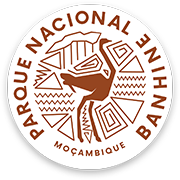Helicopter pilot from Peace Parks Foundation, Calvin Goosen, joined the veterinarian Hugo Pereira from Mozambique Wildlife Foundation on a mission to collar two herds of buffalo in Banhine National Park.
While Calvin follows the herd with the helicopter showcasing his impressive piloting skills, Dr Pereira prepares the dart before taking a shot at one of the cows. Once the animal has been darted and poses no danger to those who will be working on her, the vet then moves in and quickly blindfolds the animal to minimise her stress levels.
In a matter of minutes, a tracking collar is securely fastened around her neck, and the team administers a fast-acting reversal drug. As soon as this drug is given, it’s essential that anyone on the ground clears the area as fast as possible, as the animal is back on its feet in a matter of seconds.
Why Collar Buffalo?
Collaring operations such as these are vitally important to gather information needed by the park’s management team to make important conservation-related decisions. In an area like Banhine, where there is a dramatic difference between the dry and rainy seasons – going from a lush green marshland to a semi-arid desert – it is important to know where animals such as buffalo are moving to.
This helps us not only understand their migration patterns through the landscape but also gives guidance on where to provide water sources during the dry season to avoid human-wildlife conflict with water-dependent animals such as buffalo and elephant.



